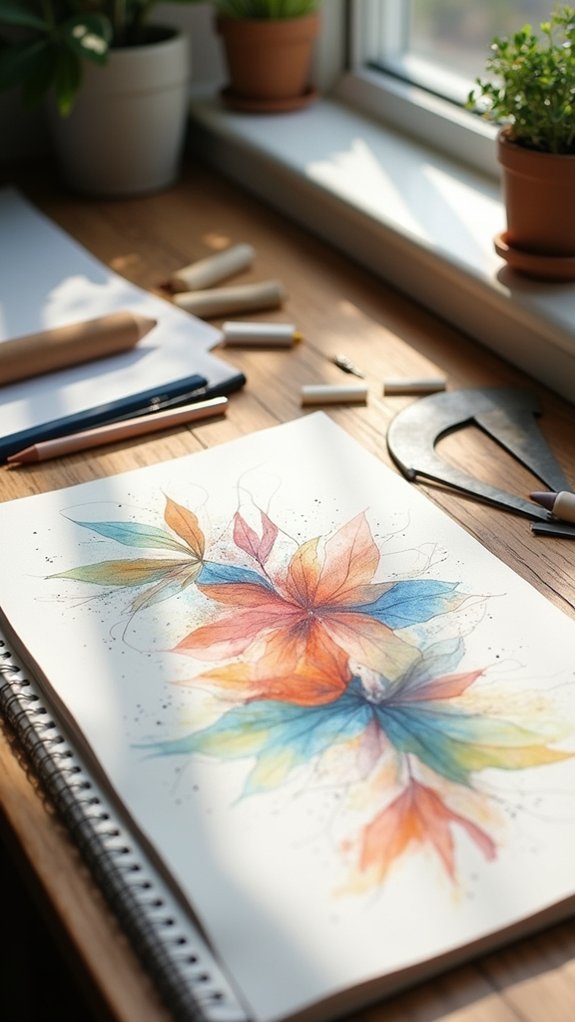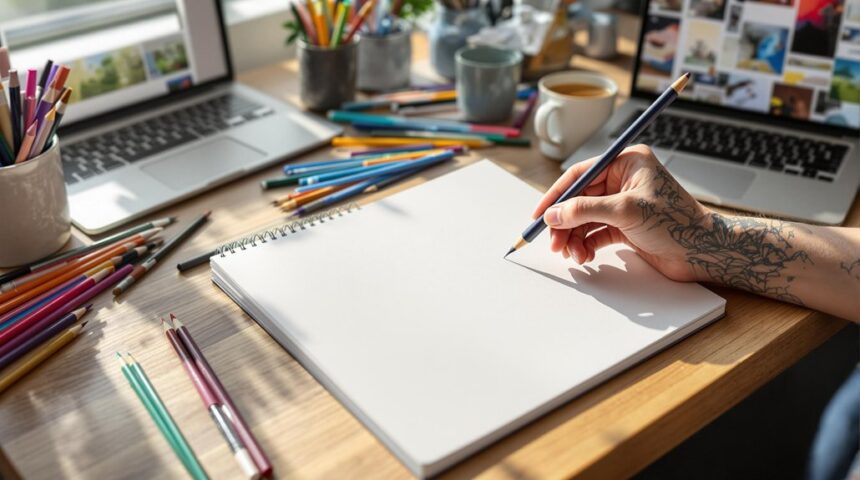Planning a sketchbook’s front page doesn’t have to be scary. Pick a theme, like “dreams” or “nature,” to give your creativity an anchor—adding a fun symbol or a cool color palette helps too! If blank pages freak you out, try starting with silly doodles or a favorite quote. Mix sketches, bold text, and personal touches, like a self-portrait, for a super-inviting vibe. With the right layout and a splash of your personality, every page after will feel easier—stick around to discover how.
Key Takeaways
- Define your sketchbook’s intent and choose a theme to serve as the creative anchor.
- Alleviate first-page pressure by starting with loose doodles or skipping directly to the second page.
- Give the front page a title, motif, or symbol that reflects your chosen theme and personal style.
- Arrange elements with a balanced layout, using focal drawings, varied shapes, and guided color palettes for visual interest.
- Add personal touches like a quote, self-portrait, or artistic goals to kickstart inspiration and ongoing motivation.
Setting Your Sketchbook’s Intent and Theme
Ever wonder why some sketchbooks just seem to glow with creativity right from the very first page? It’s not magic—it’s all about intent and theme. Before scribbling, artists often pause to set a direction for their sketchbook.
Maybe they pick a theme like nature, wild dreams, or skateboard tricks—anything that fires up their ideas. This theme becomes the anchor of their creative journey. Choosing a simple symbol or a favorite color palette for the front page can add a strong identity, almost like giving the sketchbook its own personality.
Throughout their artistic practice, keeping that original intent in mind helps maintain focus. But hey, don’t stress—explore ideas in new ways as you go, because that’s where awesome surprises can happen!
Overcoming the First Page Fear

Once someone picks a theme or a vibe for their sketchbook, things can get a little scary—especially when it’s time to face that first blank page.
Many artists feel a wave of pressure, like their entire creative journey hinges on not messing up this one spot. But here’s the thing: the first page doesn’t have to be perfect. Some artists even skip it, filling out other sketchbook pages first and coming back later when the nerves have faded.
Starting with a quick doodle, or using art materials they love, makes it less intimidating. Celebrate every small win—a fun squiggle, a new color tried!
If a mistake happens, just remember: nobody’s grading the thought process. The first page can be quirky and personal, reflecting the adventure ahead.
Visual Elements to Include on Your Front Page
A front page isn’t just a blank spot at the start—it’s the opening scene of your sketchbook’s story. This is where art comes alive!
Start by picking a title or theme that announces your creative journey. Big, bold letters? Sure! Gentle script? Go for it! Sprinkle in sketches, playful doodles, and maybe a fun quote. Personal elements are a must—write your name, draw a tiny self-portrait, or add today’s date. These touches claim your sketchbook as truly yours.
Next, think about visuals: experiment with color schemes or patterns to tie things together. You want a dynamic layout, with energy that invites people in.
Don’t fill the page completely—leave some space so you can add more awesome art later!
Layout Strategies for an Engaging Design

With all those personal touches and creative ideas in mind, the next step is figuring out how to arrange everything so the front page truly pops. Smart layout strategies can turn a page with drawings into a real attention-grabber. Try placing rectangles inside each other—a structured layout keeps things neat and boosts visual clarity. Want more excitement? Shake it up with different rectangle sizes, or use circles of color to guide the viewer’s eye. Stick an epic drawing smack in the center, then cluster smaller sketches around it for an engaging design. Don’t crowd the page: balance filled with images and empty space, and add text for personality.
| Strategy | Benefits |
|---|---|
| Rectangles-in-rectangles | Structured layout |
| Central focal drawing | Narrative flow |
| Color circles | Guides the viewer |
| Balancing text/images | Boosts visual clarity |
| Varying sizes/shapes | Dynamic, eye-catching |
Personal Touches That Inspire Ongoing Creativity
Bursting with personality, a truly inspiring sketchbook front page is more than just a good drawing—it’s a mini celebration of what makes an artist unique.
By weaving in personal touches, artists can kickstart their creativity whenever they open their sketchbook. It’s like putting a little spark of motivation right up front!
Whether it’s scribbling a personal mantra, sketching a hilarious self-portrait (even if it has crazy hair), or jotting down some ambitious artistic goals, these choices set a welcoming design that keeps the artistic journey exciting.
Here are three awesome ways to add personal touches:
- Write a personal mantra or quote that fuels your creativity.
- Draw a self-portrait or doodle that reflects your style.
- List your artistic goals for the sketchbook’s journey.
Make the first page truly yours!
Frequently Asked Questions
How to Design the First Page of Your Sketchbook?
When designing a sketchbook’s front page, one should seek front page inspiration by aligning artistic vision and personal style through chosen color schemes, typography choices, and layout ideas, possibly enhancing impact with motivational quotes or expressive introductory illustrations.
What Should I Put on the Front of My Sketchbook?
When considering what to put on the front of a sketchbook, individuals might explore front cover ideas such as personal symbols, favorite quotes, color themes, artistic styles, inspirational images, or custom lettering to reflect their creative identity.
How Do You Structure a Sketchbook?
To structure a sketchbook, one may focus on sketchbook layout by dividing creative sections, arranging pages thematically, establishing visual hierarchy, and ensuring functional designs. Page organization can be enhanced with personal touches, mind maps, and reflective annotations throughout.
What to Write in GCSE Art Sketchbook?
For a GCSE Art sketchbook, students should include artistic goals, project expectations, a materials list, inspirational quotes, artist reflections, technique exploration, and notes on personal themes, helping document creative development and communicate ideas clearly throughout the coursework.
Conclusion
Starting a sketchbook with an awesome front page really sets the stage for what’s inside. Sure, it can feel scary putting pencil to that first blank sheet, but with thoughtful planning, the page becomes a preview of creative adventures to come. Whether it’s bold doodles, silly quotes, or a splash of color, the front page reflects the artist’s vibe. So, relax, laugh at mistakes, and let excitement kick fear aside—your sketchbook journey starts now!


Leave a Reply